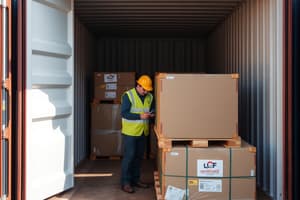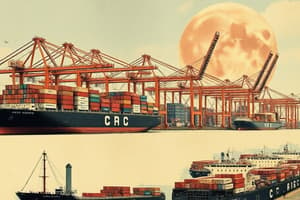Podcast
Questions and Answers
What is the primary function of Terminal Operating Systems (TOS)?
What is the primary function of Terminal Operating Systems (TOS)?
- Managing and coordinating terminal operations (correct)
- Monitoring container dwell time
- Tracking vessel movements
- Allocating equipment for container handling
Which system is used to track vessel movements?
Which system is used to track vessel movements?
- Container Dwell Time tracking system
- Automated Identification Systems (AIS) (correct)
- Radio Frequency Identification (RFID)
- Terminal Operating Systems (TOS)
What is Terminal Productivity measured by?
What is Terminal Productivity measured by?
- Container dwell time
- Number of vessels handled per hour or per day
- Time taken to complete vessel operations
- Number of containers handled per hour or per day (correct)
What is the primary goal of container terminal management?
What is the primary goal of container terminal management?
What is Vessel Turnaround Time measured by?
What is Vessel Turnaround Time measured by?
Which of the following is NOT a key function of container terminal management?
Which of the following is NOT a key function of container terminal management?
What is the primary function of Radio Frequency Identification (RFID)?
What is the primary function of Radio Frequency Identification (RFID)?
What is one of the operational challenges faced by container terminal management?
What is one of the operational challenges faced by container terminal management?
Which of the following is a key function of container terminal management related to container storage and movement?
Which of the following is a key function of container terminal management related to container storage and movement?
What is a key aspect of Equipment Management in container terminal management?
What is a key aspect of Equipment Management in container terminal management?
Which of the following is NOT an operational challenge related to safety and security in container terminal management?
Which of the following is NOT an operational challenge related to safety and security in container terminal management?
Flashcards
Berth Management
Berth Management
Managing the allocation and use of berths for container ships to maximize resource utilization.
Yard Management
Yard Management
Organizing and coordinating container storage and movement within the terminal, including stacking and retrieval.
Equipment Management
Equipment Management
Ensuring the maintenance and allocation of container handling equipment, such as cranes, trucks, and straddle carriers.
Gate Operations
Gate Operations
Signup and view all the flashcards
Terminal Operations
Terminal Operations
Signup and view all the flashcards
Congestion Management
Congestion Management
Signup and view all the flashcards
Safety and Security
Safety and Security
Signup and view all the flashcards
Equipment Maintenance
Equipment Maintenance
Signup and view all the flashcards
Labor Management
Labor Management
Signup and view all the flashcards
Terminal Operating Systems (TOS)
Terminal Operating Systems (TOS)
Signup and view all the flashcards
Automated Identification Systems (AIS)
Automated Identification Systems (AIS)
Signup and view all the flashcards
Study Notes
Container Terminal Management
Overview
- Container terminal management involves the coordination and supervision of containerized cargo operations within a port or terminal.
- The primary goal is to ensure efficient and safe handling of containers, minimizing delays and maximizing throughput.
Key Functions
- Berth Management: allocation and management of berths for container vessels, ensuring optimal use of resources.
- Yard Management: organization and coordination of container storage and movement within the terminal, including stacking and retrieval.
- Equipment Management: maintenance and allocation of container handling equipment, such as cranes, trucks, and straddle carriers.
- Gate Operations: management of truck gates, including inspection, documentation, and customs clearance.
- Terminal Operations: coordination of all terminal activities, including vessel planning, cargo handling, and inventory management.
Operational Challenges
- Congestion Management: managing high volumes of container traffic to minimize delays and optimize terminal capacity.
- Safety and Security: ensuring a safe and secure working environment, adhering to international regulations and standards.
- Equipment Maintenance: regular maintenance and repair of equipment to minimize downtime and ensure efficient operations.
- Labor Management: effective management of labor resources, including training, scheduling, and performance monitoring.
Technology and Systems
- Terminal Operating Systems (TOS): computerized systems used to manage and coordinate terminal operations, including vessel scheduling, cargo tracking, and equipment allocation.
- Automated Identification Systems (AIS): used to track vessel movements and optimize berth allocation.
- Radio Frequency Identification (RFID): used to track and monitor containers within the terminal.
Performance Metrics
- Terminal Productivity: measured by the number of containers handled per hour or per day.
- Berth Productivity: measured by the number of containers handled per hour or per day at a specific berth.
- Vessel Turnaround Time: measured by the time taken to complete vessel operations, including loading and unloading.
- Container Dwell Time: measured by the time containers spend within the terminal, from arrival to departure.
Container Terminal Management
- Involves coordinating and supervising containerized cargo operations within a port or terminal to ensure efficient and safe handling of containers.
Key Functions
- Berth Management: allocates and manages berths for container vessels, ensuring optimal use of resources.
- Yard Management: organizes and coordinates container storage and movement within the terminal, including stacking and retrieval.
- Equipment Management: maintains and allocates container handling equipment, such as cranes, trucks, and straddle carriers.
- Gate Operations: manages truck gates, including inspection, documentation, and customs clearance.
- Terminal Operations: coordinates all terminal activities, including vessel planning, cargo handling, and inventory management.
Operational Challenges
- Congestion Management: manages high volumes of container traffic to minimize delays and optimize terminal capacity.
- Safety and Security: ensures a safe and secure working environment, adhering to international regulations and standards.
- Equipment Maintenance: performs regular maintenance and repair of equipment to minimize downtime and ensure efficient operations.
- Labor Management: effectively manages labor resources, including training, scheduling, and performance monitoring.
Technology and Systems
- Terminal Operating Systems (TOS): computerized systems used to manage and coordinate terminal operations, including vessel scheduling, cargo tracking, and equipment allocation.
- Automated Identification Systems (AIS): tracks vessel movements and optimizes berth allocation.
- Radio Frequency Identification (RFID): tracks and monitors containers within the terminal.
Performance Metrics
- Terminal Productivity: measured by the number of containers handled per hour or per day.
- Berth Productivity: measured by the number of containers handled per hour or per day at a specific berth.
- Vessel Turnaround Time: measured by the time taken to complete vessel operations, including loading and unloading.
- Container Dwell Time: measured by the time containers spend within the terminal, from arrival to departure.
Studying That Suits You
Use AI to generate personalized quizzes and flashcards to suit your learning preferences.




